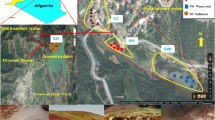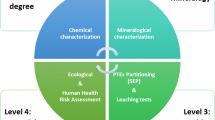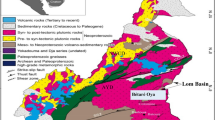Abstract
The economic benefits of mining industry have often overshadowed the serious challenges posed to the environments through huge volume of tailings generated and disposed in tailings dumps. Some of these challenges include the surface and groundwater contamination, dust, and inability to utilize the land for developmental purposes. The abandoned copper mine tailings in Musina (Limpopo province, South Africa) was investigated for particle size distribution, mineralogy, physicochemical properties using arrays of granulometric, X-ray diffraction, and X-ray fluorescence analyses. A modified Community Bureau of Reference (BCR) sequential chemical extraction method followed by inductively coupled plasma mass spectrometry/atomic emission spectrometry (ICP-MS/AES) technique was employed to assess bioavailability of metals. Principal component analysis was performed on the sequential extraction data to reveal different loadings and mobilities of metals in samples collected at various depths. The pH ranged between 7.5 and 8.5 (average ≈ 8.0) indicating alkaline medium. Samples composed mostly of poorly grated sands (i.e. 50% fine sand) with an average permeability of about 387.6 m/s. Samples have SiO2/Al2O3 and Na2O/(Al2O3 + SiO2) ratios and low plastic index (i.e. PI ≈ 2.79) suggesting non-plastic and very low dry strength. Major minerals were comprised of quartz, epidote, and chlorite while the order of relative abundance of minerals in minor quantities is plagioclase > muscovite > hornblende > calcite > haematite. The largest percentage of elements such as As, Cd and Cr was strongly bound to less extractable fractions. Results showed high concentration and easily extractable Cu in the Musina Copper Mine tailings, which indicates bioavailability and poses environmental risk and potential health risk of human exposure. Principal component analysis revealed Fe-oxide/hydroxides, carbonate and clay components, and copper ore process are controlling the elements distribution.




Similar content being viewed by others
References
Ahmari, S., Zhang, L., & Zhang, J. (2012). Effect of activator type/concentration and curing temperature on alkali-activated binder based on copper mine tailings. Journal of Materials Science, 47, 5933–5945.
Akinyemi, S. A., Akinlua, A., Gitari, W. M., Nyale, S. M., Akinyeye, R. O., & Petrik, L. F. (2012). An investigative study on the chemical, morphological and mineralogical alterations of dry disposed fly ash during sequential chemical extraction. Energy Science and Technology, 3(1), 28–37.
American Society for Testing and Materials (ASTM D 2216). (1998). Standard test methods for laboratory determination of water (moisture) content of soil and rock by mass.
American Society for Testing and Materials (ASTM D 2434-68). (2006). Standard test method for permeability of granular soils (constant head).
Beale, C. O. (1985). Copper in South Africa-Part 11. Journal of the South African Institute of Mining and Metallurgy, 85(4), 109–124.
Bennet, J. M., Sudhakar, M., & Natarajan, C. (2013). Development of coal ash—GGBS based geopolymer bricks. European International Journal of Science and Technology, 2(5), 133–139.
Bock, B., McLennan, S. M., & Hanson, G. N. (1998). Geochemistry and provenance of the Middle Ordovician Austin Glen Member (Normanskill Formation) and the Taconian Orogeny in New England. Journal of Sedimentology, 45, 635–655.
Borgese, L., Federici, S., Zacco, A., Gianoncelli, A., Rizzo, L., Smith, D. R., et al. (2013). Metal fractionation in soils and assessment of environmental contamination in the Vallecamonica, Italy. Environmental Science and Pollution Research International, 20(7), 5067–5075.
Brandl, G. (1981). The geology of the Messina area. Tech. Rep. Explanation sheet 2230, Geological Survey of South Africa, Messina, Italy.
Cao, X., Wang, X., & Zhao, G. (2000). Assessment of the bio-availability of rare earth elements in soils by chemical fractionation and multiple regression analysis. Chemo-sphere, 40, 23–28.
Ekosse, G., Van Den Heever, D. J., De Jager, L., & Totolo, O. (2004). Minerology of Tailings dump around Selebi Phikwe nickel-copper plant, Botswana. Journal of Applied Science in Environmental Management, 8(1), 37–44.
Fadiran, A. O., Tiruneh, A. T., & Mtshali, J. S. (2014). Assessment of mobility and bioavailability of heavy metals in sewage sludge from Swaziland through speciation analysis. American Journal of Environmental Protection, 3, 198–208.
Fedo, C. M., Nesbitt, H. W., & Young, G. M. (1995). Unraveling the effects of potassium metasomatism in sedimentary rock sand paleosols, with implications for paleoweathering conditions and provenance. Geology, 23, 921–924.
Folk, R. L., & Ward, W. O. (1957). Brazos River bar: A study in the significance of grain size parameters. Journal of Sedimentary Petrology, 27, 3–26.
Rao, F., & Liu, Q. I. (2015). Geopolymerization and its potential application in mine tailings consolidation: A review. Mineral Processing and Extractive Metallurgy Review, 36, 399–409. https://doi.org/10.1080/08827508.2015.1055625.
Geotechnical Test Method-7. (2015). Test method for liquid limit, plastic limit, and plasticity index. State of New York Department of Transportation Geotechnical Engineering Bureau.
Harnois, L. (1988). The CIW index: A new chemical index of weathering. Sedimentary Geology, 55, 319–322.
Hudson-Edwards, K. A., & Dold, B. (2015). Mine waste characterization, management and remediation. Minerals, 5, 82–85.
Hudson-Edwards, K. A., Jamieson, H. E., & Lottermoser, B. G. (2011). Mine wastes, Past, Present, Future. Elements, 7, 375–380.
International Association of Risk Compliance (IARC). (2004). Some drinking-water disinfectants and contaminants, including arsenic. IARC Monographs on the Evaluation of Carcinogenic Risks to Humans, 84, 1–477.
Jakubick, A., & McKenna, G. (2003). Stabilisation of tailings deposits: international experience. Mining and the Environment III, Sudbury, Ontario, Canada, 25–28 May, 2003, pp 1–9.
Keller, C., & Hammer, D. (2004). Metal availability and soil toxicity after repeated croppings of Thlaspi caerulescens in metal contaminated soils. Environmental Pollution, 131, 243–254.
Kersten, M., & Forstner, U. (1989). Speciation of trace elements in sediments. In G. E. Batley (Ed.), Trace element speciation: Analytical methods and problems (pp. 245–318). Boca Raton: CRC Press.
Lottermoser, B. G. (2010). Mine wastes: Characterization, treatment, and environmental impacts (3rd ed., p. 400). Berlin Heidelberg: Springer.
Madrid, F., Reinoso, R., Florido, M. C., Díaz Barrientos, A., Ajmone-Marsan, F., Davidson, C. M., et al. (2007). Estimating the extractability of potentially toxic metals in urban soils: A comparison of several extracting solutions. Environmental Pollution, 147, 713–722.
Mahmood, A. A., & Mulligan, C. N. (2007). Investigation of the use of mine tailings for unpaved road base construction. In Proceedings of the annual international conference on soils, sediments, water and energy, 12, Article 11.
Nehdi, M., & Tariq, A. (2007). Stabilization of sulphidic mine tailings for prevention of metal release and acid drainage using cementations materials: A review. Journal of Environmental Engineering and Science, 6(4), 423–436.
Nesbitt, H. W., & Young, G. M. (1982). Early Proterozoic climates and plate motions inferred from major element chemistry of lutites. Nature, 299, 715–717.
Ogola, J. S., & Sebola, A. M. (2010). Investigation of heavy metals dispersion around the Messina copper mine tailings dam, South Africa. In Proceedings of the IASTED international conference, Vol. 888, pp. 15–17
Pacheco-Torgal, F., Castro-Gomes, J., & Jalali, S. (2007). Investigation about the effect of aggregates on strength and microstructure of geopolymeric mine waste mud binders. Cement and Concrete Research, 37, 933–941.
Pacheco-Torgal, F., Castro-Gomes, J., & Jalali, S. (2008). Properties of tungsten mine waste geopolymeric binder. Construction and Building Materials, 22, 1201–1211.
Quispe, D., Pérez-López, R., Silva, L. F. O., & Nieto, J. M. (2012). Changes in mobility of hazardous elements during coal combustion in Santa Catarina power plant (Brazil). Fuel, 94, 495–503. https://doi.org/10.1016/j.fuel.2011.09.034.
Rahman, M., Vahter, M., Sohel, N., Yunus, M., Wahed, M. A., Streatfield, P. K., et al. (2006a). Arsenic exposure and age and sex specific risk for skin lesions: A population-based case-referent study in Bangladesh. Environmental Health Perspectives, 114, 1847–1852.
Rahman, M., Vahter, M., Wahed, M. A., Sohel, N., Yunus, M., Streatfield, P. K., et al. (2006b). Prevalence of arsenic exposure and skin lesions. A population based survey in Matlab, Bangladesh. Journal of Epidemiology and Community Health, 60(3), 242–248.
Rao, R. M., Sahuquillo, A., & Lopez Sanchez, J. F. (2008). A review of the different methods applied in environmental geochemistry for single and sequential extraction of trace elements in soils and related materials. Water, Air, and Soil Pollution, 189, 291–333.
Rath, P., Panda, U. C., Bhatta, D., & Sahu, K. C. (2008). Use of sequential leaching, mineralogy, morphology and multivariate statistical technique for quantifying metal pollution in highly polluted aquatic sediments—A case study: Brahmani and Nandira Rivers, India. Journal of Hazardous Materials, 163(2–3), 632–644. https://doi.org/10.1016/j.jhazmat.2008.07.048.
Rauret, G., López-Sánchez, J. F., Bacon, J., Gómez, A., Muntau, H., & Quevauviller, P. (2001). Report EUR 19774 EN. European Commission; Brussels: Certification of the Contents (Mass Fractions) of Cd, Cr, Cu, Ni, Pb and Zn in an Organic-Rich Soil Following Harmonised EDTA and Acetic Acid Extraction Procedures, BCR-700, p. 61
Saeed, A., & Zhang, L. (2012). Production of ecofriendly bricks from Cu mine tailings through geopolymerization. Construction and Building Materials, 29, 323–331.
Salomons, W. (1995). Environmental impact of metals derived from mining activities: Processes, predictions, prevention. Journal of Geochemical Exploration, 52, 5–23.
Singo, N. K. (2013). An assessment of heavy metal pollution near an old copper mine dump in Musina, South Africa. M.Sc. Thesis. The University of South Africa.
Tokalioglu, S., Kartal, S., & Irol, G. B. (2003). Application of a three-stage sequential extraction procedure for the determination of extractable metal contents in highway soils. Turkish Journal of Chemistry, 27, 333–346.
van Jaarsveld, J. G. S., van Deventer, J. S. J., & Schwartzman, A. (1999). The potential use of geopolymeric materials to immobilize toxic metals: part II. Material and leaching characteristics. Minerals Engineering, 12, 75–91.
Voicu, Gn, & Bardoux, M. (2002). Geochemical behaviour under tropical weathering of the Barama–Mazaruni greenstone belt at Omai gold mine, Guiana Shield. Applied Geochemistry, 17, 321–336.
Voicu, G., Bardoux, M., Harnois, L., & Grepeau, R. (1997). Lithological and geochemical environment of igneous and sedimentary rocks at Omai gold mine, Guyana, South America. Exploration and Mining Geology, 6, 153–170.
Wilson, M. G. C. (1998). Copper. In M. G. C. Wilson & C. R. Anhaeusser (Eds.), The mineral resources of South Africa (pp. 209–227). Pretoria: Council of Geosciences.
World Health Organisation (WHO)/International Programme Chemical Safety (IPCS). (2001). Environmental health criteria 224, arsenic and arsenic compounds (2nd ed.). Geneva: World Health Organization.
Yang, J. S., Lee, J. Y., Baek, K., Kwon, T. S., & Choi, J. (2009). Extraction behavior of As, Pb, and Zn from mine tailings with acid and base solutions. Journal of Hazardous Materials, 171(1–3), 443–451.
Yunus, M., Sohel, N., Hore, S. K., & Rahman, M. (2011). Arsenic exposure and adverse health effects: A review of recent findings from arsenic and health studies in Matlab, Bangladesh. The Kaohsiung Journal of Medical Sciences, 27(9), 371–376.
Zhang, L. (2013). Production of bricks from waste materials—A review. Construction and Building Materials, 47, 643–655.
Zhang, L., Ahmari, S., & Zhang, J. (2011). Synthesis and characterization of fly ash modified mine-based geopolymers. Construction and Building Materials, 25, 3773–3781.
Zou, D. H., & Li, L. P. (1999). Strengthening of solidified dilute tailing slurry. Journal of Geotechnical and Geoenvironmental Engineering, 125, 11–15.
Acknowledgements
The authors would want to acknowledge the support from ESKOM Foundation, NRF, and THRIP for funding this study through student bursaries and consumables.
Author information
Authors and Affiliations
Corresponding author
Rights and permissions
About this article
Cite this article
Gitari, M.W., Akinyemi, S.A., Ramugondo, L. et al. Geochemical fractionation of metals and metalloids in tailings and appraisal of environmental pollution in the abandoned Musina Copper Mine, South Africa. Environ Geochem Health 40, 2421–2439 (2018). https://doi.org/10.1007/s10653-018-0109-9
Received:
Accepted:
Published:
Issue Date:
DOI: https://doi.org/10.1007/s10653-018-0109-9




